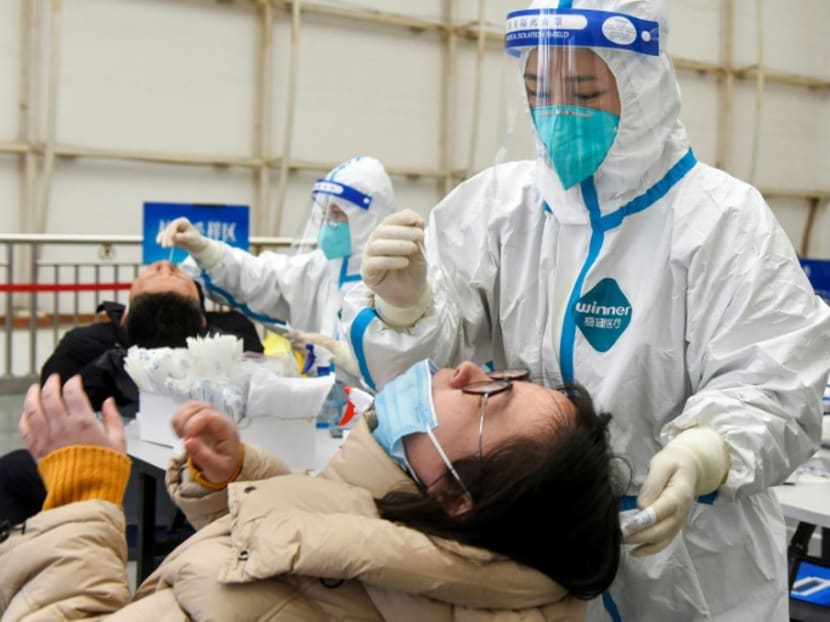Commentary: ‘Zero-COVID’ is no longer the real goal for China
Few picked up on the country’s shift away from a zero-COVID strategy in November 2021. And a bigger shift may be on the cards this year, NUS East Asia Institute’s Chen Gang explains.

China is battling multiple small outbreaks of COVID-19. (File photo: AFP/STR)
SINGAPORE: About the same time when the new Omicron variant was first reported to the World Health Organization (WHO) in November 2021, China shifted towards a new approach - to what is termed a “dynamic zero-COVID” approach to replace its zero-tolerance policy.
According to Liang Wannian, head of China’s COVID-19 task force, the goal of the new policy was to prevent domestic flare-ups through timely interventions, rather than achieve zero infections.
Compared to its early zero-tolerance stance, this flexible approach allowed for more relaxed rules alongside a suite of measures focused on rapidly eliminating any new infections. This includes early detection, frequent contact tracing, long quarantines and strict border controls.
What this now means is that a couple of reported infections will no longer trigger a lockdown of a whole city.
Instead, targeted lockdown measures among specific communities rather than entire cities or provinces are applied promptly once more than two new cases are spotted in a community within 14 days.
Under this “dynamic” policy, more emphasis has been placed on striking a balance between disease control and enabling people to live normal lives.
For example, susceptible villages can adopt stricter measures around their borders, including setting up checkpoints and imposing restrictions on people's movements, while their areas within need not have such restrictions.
Yet this shift went unnoticed by most of the world. And because lockdowns of Chinese provinces and cities have persisted in recent weeks, China’s approach continues to come under international criticism.
With Omicron’s greater transmissibility, China too knows moving towards endemic living might be inevitable. But now is not the time for China to shift to living with COVID-19 when the high-stakes Beijing Winter Olympics are proceeding.
Still, Chinese authorities’ emphasis on the “dynamic” nature of its approach may signal that the Chinese government is ready to be more flexible and loosen restrictions gradually.
“DYNAMIC” JUST MEANS CHINA IS SHIFTING ITS POLICY
China was the birthplace of the first COVID-19 lockdown after the first cases were reported in Wuhan in January 2020. This was not an easy decision but seemed to have paid off.
Over the past two years, China’s zero-tolerance policy helped the country to successfully contain COVID-19 cases at low levels, allowing it to achieve the high 8.1 per cent economic growth in 2021.
Few had expected the pandemic to continue unabated into the third year, so the costs of lockdowns and stringent rules were assumed to be temporary and necessary.
Chinese authorities know that with a more transmissible and dominant variant Omicron, such an elimination strategy will no longer be cost-effective, and must be reviewed.
China too has felt the economic and social costs of strict curbs including the disruption of supply chains, a slowdown of services and drop in cross-border travels.
In November 2021, Liang, in an interview introducing China’s new “dynamic” approach, said China’s control and prevention measures had to be precise and prompt, with more focus on treatment and medical research in its overall COVID-19 management.
Liang acknowledged that fatigue and discontent among the Chinese population have grown after two years of strict measures. But he also pointed out how the Chinese people’s altruism has enabled the country to contain the pandemic so far.
On Dec 11, 2021, the Chinese State Council held a special press conference on COVID-19 control, reinforcing the same stance.
PUBLIC SENTIMENTS IN CHINA ARE CHANGING
What might have sparked this change of heart? Public sentiments regarding strict control measures may have reached a boiling point in China.
Under the old zero-COVID approach, each time infections are detected, people had to undergo sometimes repeated mass nucleic acid testing and potential citywide lockdowns.
Those who had not undergone required testing were nervous about seeing their health code turn amber in their COVID-19 app’s traffic-light system, prohibiting them from entering venues or travelling.
Most Chinese people have accepted the narrative that living with COVID-19 is not a viable approach in China because it would cause large numbers of severe illnesses and deaths.
The Chinese Center for Disease Control and Prevention recently published a paper estimating China could see over 630,000 daily cases if it were to relax rules and follow the strategies in advanced economies like the United States and United Kingdom.
They also understood that this is a politically important year when Beijing is holding both the Winter Olympics and the 20th Party Congress.
But the huge inconveniences and difficulties imposed upon people’s livelihoods and lifestyles may be turning the wheels of the Chinese policy machinery to consider some kind of policy adjustment.
The prospect of spending another year away from families over the Spring festival holiday can be painful.
Chinese authorities know the risks of this stewing frustration can be huge. In countries like Belgium, the US and the Netherlands, tens of thousands took part in demonstrations against COVID-19 restrictions.
Such large-scale protests have not been seen in China, but according to the Edelman Trust Barometer, people’s trust in the Chinese government had dropped about 8 percentage points between 2020 and 2021, though it regained 9 percentage points early this year.
Last year’s survey result suggested holding onto a rigid zero-tolerance policy may backfire and further erode political trust in the country.
That is unacceptable to the ruling Communist Party in a year of its 20th Party Congress at which General Secretary Xi Jinping is expected to have a third term confirmed amid a massive reshuffling at the top levels in the party.
THE GDP IMPERATIVE
A lot has been said about how China’s zero-COVID policy was a growth-at-all-cost policy in disguise. This narrative misses the point that gross domestic product figures are still important for China to achieve its mid- and long-term goals in its national Five-Year Plan and its vision for 2035.
The reality of a rapidly ageing population is that China must get rich before it gets old to avoid the middle-income trap, a development stage in which a country attains a certain level of income but stagnates after failing to complete modernisation.
Based on this, China needs to double the size of its economy by 2035, which requires an average annual growth rate of 4.7 per cent until then.
But staying closed cannot help China achieve this. Goldman Sachs has already cut its 2022 forecast for China economic growth to 4.3 per cent, down from 4.8 per cent previously, due to concerns about increased restrictions on business activity to contain the Omicron variant.
And so the Chinese leadership has indicated that China’s economic policy for 2022 is to “prioritise stability while pursuing progress”. To achieve both social stability and economic recovery, the country needs to maintain GDP growth rate at around 5 per cent.
It will be difficult to do that if its stiff measures are not loosened up to some extent this year. Both the energy crunch and supply chain disruptions last year showed that the Chinese economy, facing huge internal and external uncertainties, is on fragile footing.
SOME CONDITIONS MUST BE FULFILLED
Still, even if China is prepared for a more dynamic and flexible pandemic policy, it will be unrealistic to expect the government to ease restrictions significantly when the Beijing Winter Olympics and the National People’s Congress annual session are around the corner.
A more realistic timeline is after March. Yet, until the Party Congress in autumn, any such adjustment will be carried out with restraint.
Another crucial condition hinges on the development of homegrown mRNA vaccines. Chinese biotech company Suzhou Abogen Biosciences and partner Walvax Biotechnology have started clinical trials, with preliminary results looking promising.
Their vaccines may provide higher levels of protection against the Omicron variant than existing Chinese-made shots.
A wide application of domestic mRNA vaccines, which will produce a stronger immune response than the prevailing inactivated virus technology, could in turn provide the Chinese government the space to shorten quarantine periods and allow vaccinated people to travel more freely.
More importantly, breakthroughs in the area could allow China to shift towards endemic living more fully and jettison its “dynamic” zero-COVID policy.
Chen Gang is Assistant Director and Senior Research Fellow of the East Asian Institute, National University of Singapore.










